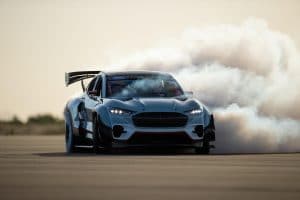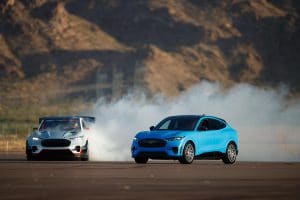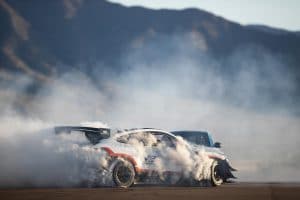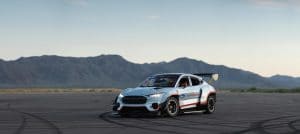
The Mach-E 1400 Prototype will explore ways the all-electric SUV could be used on track or in drifting programs.
Smokin’! For those who don’t think the planned Mustang Mach-E GT will make enough power, the Detroit automaker pulled the wraps off a new version of the battery-electric vehicle and as its name suggests, the Mach-E 1400 Prototype will punch out a peak 1,400 horsepower.
That’s more than three times the projected output of the Mustang Mach-E GT set to expand the EV line-up next year, making an impressive enough 459 hp. The downside: the Mach-E 1400 is a one-of-a-kind prototype track car.
“Getting behind the wheel of this car has completely changed my perspective on what power and torque can be,” said Vaughn Gittin Jr., a motorsports champion and founder of RTR Vehicles, which worked with Ford to develop the prototype. “This experience is like nothing you’ve ever imagined, except for maybe a magnetic roller coaster.”
(As order banks open, Ford upgrades Mustang Mach-E performance specs.)
Ford plans to bring entry and mid-level versions of the Mach-E to market before the end of the year, the program serving as the flagship of the automaker’s $11.5 billion electrification program. The top-end – street-legal Mach-E GT – will follow sometime during 2021, Ford has said.

The Mach-E 1400 Prototype makes more than three times the power of the planned Mustang Mach-E GT – but also has five more motors.
In keeping with the latest trend in battery-electric vehicle, or BEV, design, all versions of the Mach-E will rely on a skateboard-like platform mounting batteries and motors below the load floor. And, much as rival Tesla has done, the flexible Ford architecture will allow it to offer buyers a mix of powertrain configurations and range options.
The base Mustang Mach-E will rely on a single electric motor on the rear axle, the mid-price package adding a second, smaller motor up front. The GT uses a larger front motor to boost total output to 459 hp and 612 pound-feet of torque.
The Mach-E 1400, on the other hand, relies on fully seven electric motors. And that’s just one of the revisions made for the track.
“Three are attached to the front differential and four are attached to the rear in pancake style, with a single driveshaft connecting them to the differentials, which have a huge range of adjustability to set the car up for everything from drifting to high-speed track racing,” the automaker said in a release revealing details about the Mach-E 1400.
The prototype isn’t yet ready for racing, at least not competitively. For now, Ford describes it as a “research project.” And that means significant flexibility to explore the best way to put all that power to the pavement. Indeed, the Mach-E 1400 can send all power to one axle or the other or blend it between front and back, as needed.
“The challenge was controlling the extreme levels of power provided by the seven motors,” said Mark Rushbrook, motorsports director, Ford Performance. “Mustang Mach-E 1400 is a showcase of the art of the possible with an electric vehicle.”
(Ford Mustang Mach-E first edition sold out.)
The plan is to explore different layouts for the drivetrain – something that likely will vary depending upon what type of circuit the 1400 will be set up for. Things like steering, as well as control arms and other suspension components, will need to be changed, depending on whether the prototype is being used for drift or track, for example.
For most of the body, Ford turned to super-strong and ultralight carbon fiber. The hood, however, is made of a fibrous organic compound.
Aerodynamics were key to the design, and the Mach-E 1400 produces a whopping 2,300 pounds of downforce at 160 mph. While electric vehicles typically need less airflow under the hood than a vehicle with an internal combustion engine, the racer will need substantially more cooling than the street car for its motors, battery, power electronics and larger Brembo blended brake system. The system can recapture energy normally lost during braking and coasting and send it back to the batteries.
Meanwhile, to enable drifting, the Mach-E 1400 features a hydraulic handbrake system that, when activated, shuts off power to the rear motors.
A special di-electric cooling system has also been integrated into the battery pack itself to minimize downtime between runs. Power comes from a 56.8 kilowatt-hour pack using a nickel manganese cobalt formulation emphasizing power density. The key here is a high discharge rate, Ford explained, the amount of power that can be sent to the motors in a hurry.
(Ford reduces charging time for Mustang Mach-E by as much as 30 percent.)
“Now is the perfect time to leverage electric technology, learn from it, and apply it to our lineup,” said Ron Heiser, chief program engineer, Mustang Mach-E. “Mustang Mach-E is going to be fun to drive, just like every other Mustang before it, but Mustang Mach-E 1400 is completely insane, thanks to the efforts of Ford Performance and RTR.”


